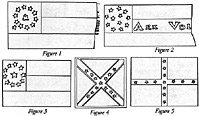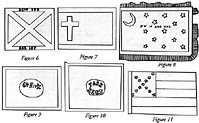The night Bill Clinton was elected president, he appeared at the front of the Old State House in Little Rock. That event, complete with the shimmy by Hillary and Tipper, thrust the venerable old building back into the historical limelight.
But the Old State House already had witnessed a lot of other history. It was the place where, in 1861, the Arkansas Legislature voted to secede and it was the seat of the Confederate government until that administration was replaced by occupying Federal troops.
The Old State House has another strong link to the Civil War in Arkansas. It is the repository of a collection of battle flags from the war. The flags were trophies, captured by Union soldiers and held by the U.S. War Department until 1905, when they were returned.
The collection is a motley one, reflecting the diversity and lack of standardization among Confederate battle flags in the Western theater. With one exception, the flags depicted here are from that theater, which, of course, is where the vast majority of Arkansas troops fought during the Civil War.
The figures accompanying this article represent all the major flag patterns in the collection. The figures are not necessarily drawn to scale with each other, but dimensions of the flags are given. The vertical height (staff) of the flag will be given first, the horizontal length (fly) second.
The battle honors on the flags have been omitted for several reasons. First, such honors are the devil to trace. And the appearance of battle honors, which were added in sequence, reflects the latest period of any particular flag's use, rather than the flag's appearance in an earlier period. Finally, those using these flag patterns for their wargame campaigns may not be especially interested in historical battle honors for imaginary campaigns and possibly imaginary units. For those who want to see the flags with their full battle honors, however, this can done easily enough by using the short bibliography at the end of the article.
Figure 1
The first three figures are variations of the Confederate National Flag, the "Stars and Bars." Figure 1 depicts a flag that dates from 1861 and was carried by the Eighth Arkansas Volunteer Infantry, probably until no later than early 1862. The stars in the circle represent the eleven states of the Confederacy, with the central star superimposed over the letter "A" for Arkansas. The twelfth star, outside the original circle, is assumed to represent Missouri. The flag measures 21 by 39 inches. The canton is blue with white stars. The horizontal bars on the field (from the top) are red, white and red.
Figure 2
A variation on the First National Flag has twelve stars in its canton, nine in a circle and three inside that circle. The flag was carried by an unknown unit but carries the designation "Ark Vol" for Arkansas Volunteers. The flag measures 27 by 58 inches. The canton is blue, its stars white. The bars are red, white, and red, like the preceding flag, and the letters on the white bar are colored red.
Figure 3
Another flag from an unidentified unit, also in the First National Flag pattern, although it represents yet another variation. Eleven stars appear in the canton, ten forming a circle around the eleventh, which is somewhat larger than the others. The flag measures 46 by 69 H inches. Once again, the canton is blue and the stars are white. The horizontal bars are the standard red, white, and red.
Figure 4
The only example in this review from the Eastern Theater, this flag was carried by the Third Arkansas Volunteer Infantry, part of the Army of Northern Virginia's Texas Brigade. The Third Arkansas was the only Arkansas unit in that army and was raised from Ashley and Union counties (that's home, folks.) The flag appears to have been made privately, as it is somewhat smaller than the 48 inch square measurement of the army's standard battle flags. This flag is 47 by 46 inches and is in the well-known colors: red field, blue St. Andrew's cross, white edging to the cross and white border on the flag.
Figure 5
This is a variation of the Polk pattern flag, a common flag in the West. This one differs from the more typical flags in this pattern in that the cross is not edged in white, and thirteen stars, rather than eleven, appear. The flag was carried by an unknown unit but appears to have been made in the summer of 1862. It was captured in Arkansas. The flag is 53 by 72 inches. The field is blue, the cross red, and the stars white.
Figure 6
This is a flag of the 30th Arkansas Volunteer Infantry. This flag pattern was carried by McMown's Third Division in the Kentucky Campaign. The pattern is said to have been adopted to distinguish units of the Third Division from those of the Fourth, which carried flags of the Hardee and Polk patterns. This flag was captured at Murfreesboro in December, 1862. The flag measures 40 by 46 inches. The field is blue, the cross and border white.
Figure 7
This figure depicts the flag of the Ninth Battalion, Missouri Volunteer Sharpshooters, a unit that saw considerable action in Arkansas. This pattern was carried by many Missouri units and this particular flag was issued to the Ninth Battalion in late 1863 or early 1864. The flag measures 35 H by 48 I inches. Its field is blue, the cross white, and the border is red.
Figure 8
This is an example of the Van Dorn pattern flag, a pattern adopted in early 1862, for Earl Van Dorn's Army of the West. That army eventually became Van Dorn's Corps of the Army of the Mississippi. This particular flag belonged to the Northwest 15th Arkansas Volunteers, a unit that fought at Wilson's Creek, Pea Ridge, and other places. In this pattern, the crescent represents Missouri; the stars represent other states officially in the Confederacy, as well as Kentucky and Maryland. The flag measures 45 H by
68 I inches. The field is red; the crescent, border and fringe are yellow; and the lettering is white. Variations of this pattern included different arrangements of the stars, a white crescent, and occasionally, a white fringe or border.
Figure 9
The next two figures depict Hardee pattern flags, which were carried by units in Hardee's Corps. Several other examples of Hardee flag s are also in the Old State House collection but are not depicted here. They are distinguishable from each other mainly by varying widths of their borders and by varying designs of the central disc, which could range from circular to elliptical to almost rectangular, though with the corners still rounded. This particular flag was carried by the 6th Arkansas Volunteer Infantry. The flag is believed to date from early 1862 and was replaced by another version later that same year. The flag measures 31 H by 43 H inches. The field is blue, the disc white and the lettering is black.
Figure 10
Another example of the Hardee pattern, this flag was carried by the combined 1st and 15th Volunteer Infantry and probably was issued in the summer of 1864 when those two units were consolidated. The flag is pictured in John McDonald's Great Battles of the Civil War (1988), which mentions the "distinctive green" color of the flag. But the flag was originally issued in the standard blue and white Hardee pattern colors. The poor quality dye used for this flag faded to green, but exactly when that occurred isn't clear. This flag saw only brief service, being captured in Georgia in September 1864. The flag measures 30 H by 38 H inches. Original colors were as noted for Figure 9. The lettering on the disc spells out "1st Ark Regt."
Figure 11
This flag of the combined 22nd and 20th Arkansas Volunteer Infantry appears to be a
variation of the Second National Flag of the Confederacy, the "Stainless Banner," adopted in 1863. This variant uses red and white stripes on the field to circumvent the problem presented by the white field of the Stainless Banner, which could easily be confused with a flag of surrender. This flag measures 20 by 33 inches. The canton is blue; the stars are white (one star appears to be missing from the upper left corner of the canton); the horizontal bars are colored (from the top) white, red, white, red, and white.
The many flag patterns depicted in the Old State House and the many variations of those patterns that were used by the Confederate units in the West are indicative of the lack of central supply and coordination that plagued that theater of war. Along with the major differences among the flags are the minor ones too. Note, for example, how the stars rarely "point" in any particular direction. The stars generally are oriented "willy-nilly," rather than with one point straight up, the pattern with which we are the most familiar today.
If the overriding feature of these flags is their improvised, homemade look, there is one final point to consider in organizing wargame Civil War armies.
The many beautiful, computer-generated flags now available from suppliers are a tremendous asset to those creating miniature armies. This is not meant to take anything away from the producers of these flags, but in your Southern units, hand-painted flags may have a more realistic look, especially if your hand is not always perfectly steady. It's that very hand-made character that gives your flags their homely authenticity.
Confederate Battle Flags in the Collection of the Old State House, Department of Arkansas Heritage, Little Rock, Arkansas, 1988.
The Battle Flags of the Confederate Army of Tennessee, by Madaus, Howard Michael and Needham, Robert D. Morningside Press, Dayton, Ohio.
Related:
This article appears in MagWeb (Magazine Web) on the Internet World Wide Web.

Conclusion
Bibliography
Back to The Zouave Vol VIII No. 1 Table of Contents
Back to The Zouave List of Issues
Back to Master Magazine List
© Copyright 1994 The American Civil War Society
Other military history articles and gaming articles are available at http://www.magweb.com